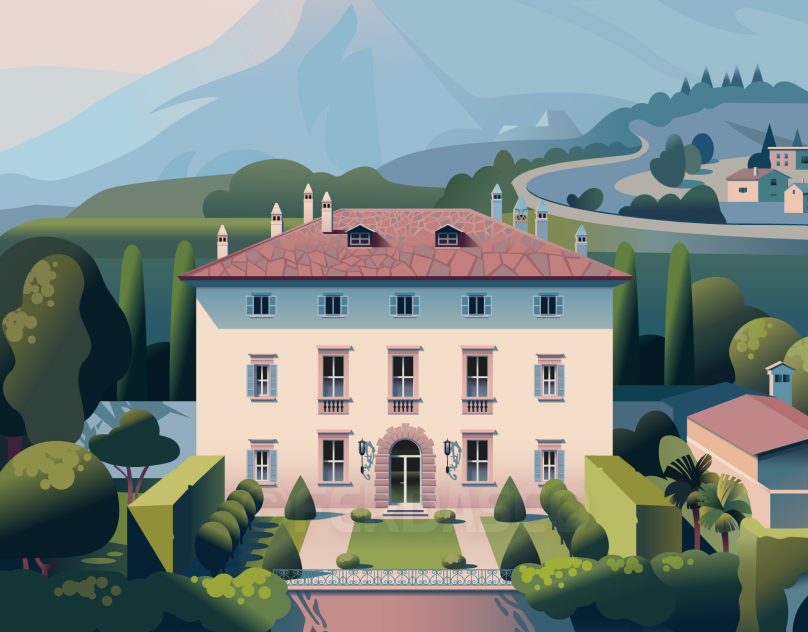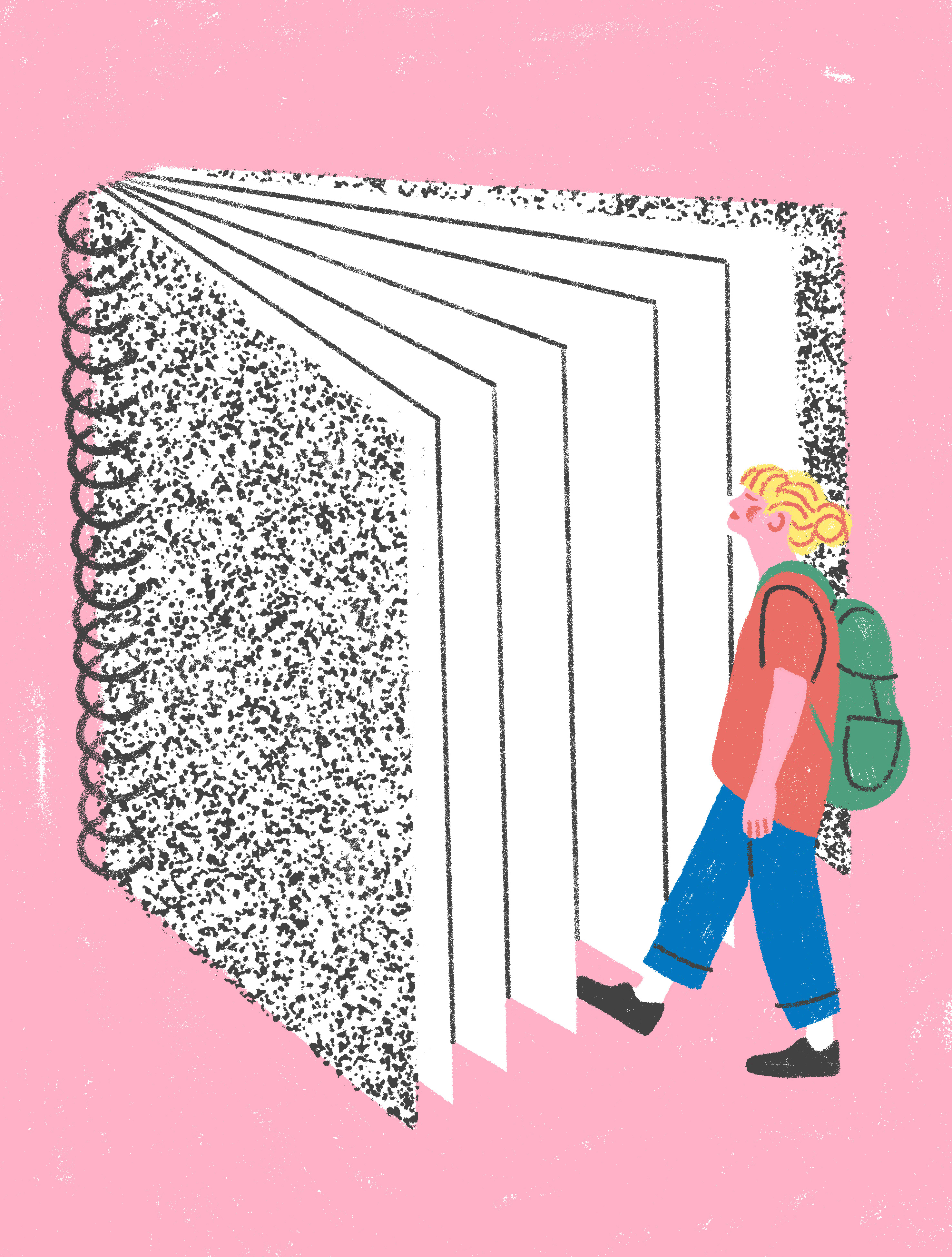What happened when oil platform dies? (dies here means when the natural source; gas and oil, finished and there are no more to be suck out of the earth.) Would the platforms be left at its place, or would it be dismantled and brought to shore? Which of the options would be a good and beneficial one? and if the platforms were to be left in place, what could it be next, would it be abandoned, unintended, or be replaced with different programs which would continue generate income as it have been doing for the past years. If it going to be occupy by different programs, what kind of programs that could attract users.
The platform does not only house the workers, as the structure goes in the sea, it has been the man-made habitat for the marine life. They adapted to the platform structure after some time and they turned it to be their habitat. Would people go for or against the removal of the structure which means removal of the marine habitat, leaving the marine community ‘homeless’. As oil platforms are situated in the deep sea mostly, electricity are being generated by the generator machine placed in the structure.
Nowadays, people are moving towards green design approach and using generator to generate energy is not anywhere near the intention. Using nature’s endless energy to create energy for the building is such a Nobel challenge for a project.
Marine tourism is not a very explored category of tourism. Apart from cruise, floating resorts near shore, diving and water sports, there are not many places explored for sea tourism although the earth is 70 percent covered by water. The world is also now challenged by the threat of global warming, where ices are melted, having water level increases and land were flooded. Where else people would live when there is no land to be lived on?
This project is a visionary project where it promotes the not much explored tourism, provides an alternative plan for the platforms when the time comes, suggesting what could be done in creating energy using natural sources and preserving the natural biodiversity in the sea.
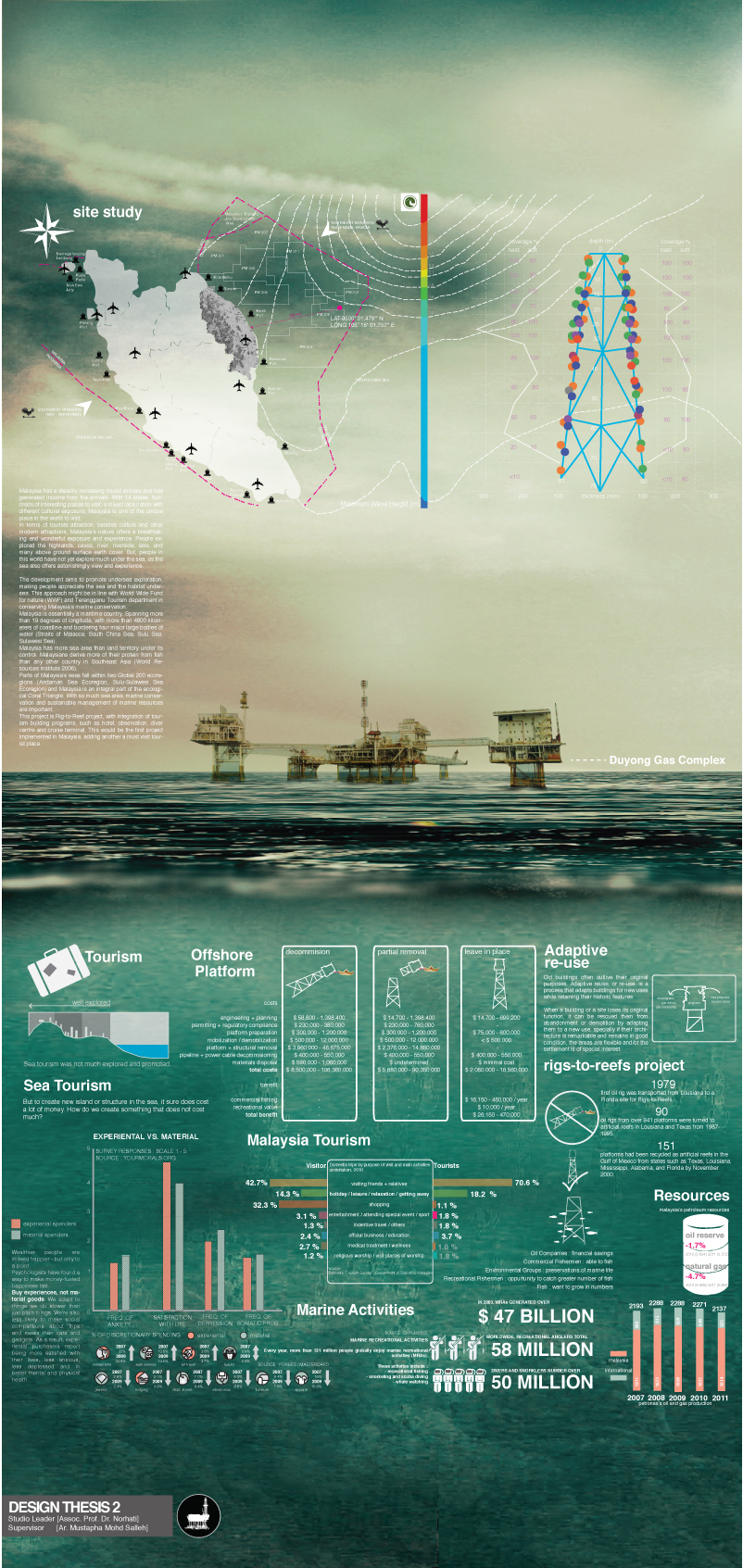
Presentation Board 1
The project introduction, issue & research, site + existing building
Introduction
This project is an adaptive re-use of gas complex in Terengganu coast. The project is a visionary project where the client vision the future, what would happen and how it should happen. It is named Duyong : The Exotic Tourism Complex because the programs offered could not be found in the shore, it is an exotic experience for the people who visit this place. A complex where it used to be the gas complex for the nation, the facilities for water sports in the middle of the sea, underwater tunnel that exhibits nature wild life and corals, exposure to the natural environment and the experience of living in the sea; that is why it is called exotic.
Background
In creating a new development in the sea, it may requires lot of funds and work, for example the Dubai Palm Island, where billion dollars spent just to create artificial island. Furthermore, oil rig or oil platform that had been constructed to serve the oil and gas collection process would be dismantled or sunken after the source is finished at the spot. The controversial issues that being argued is the disassemble of the structure, as fish and other habitat already live at and around the platform. The rig’s steel structure are stable and durable. They create shelter for marine life in open waters where there was none.
Decommissioning an oil rig is the act of removal according to regulatory requirements and includes flushing, plugging and cementing wells to make them safe. Decommissioning is complicated by factors such as cost, safety, operational duration, environmental issues, risk, experience, and historical relationship between operator and state.
For decommissioning, severing the rig from the bottom using explosives is the easiest approach, but has the potential to harm marine life. This potential is greatly reduced if the explosives are all placed deep below the seafloor.
The other issue is cost, where decommissioning the oil rig costs lot of money and when we have an option, which benefits both party (in this case, the operator of the oil rig and nature), it is better to take the initiative in preserving the nature and the cost of decommissioning could be use in refurbishing the oil rig.
For this project, in preserving the man-made habitat, the oil rig would be in its original form, only refurbishment of the structure and integration of new programs.
City of Tomorrow
How do we imagine the cities of tomorrow? This is the one of the most difficult questions that architects, designers, and urban planners need to answer in a time where more than half of the world’s population lives in urban resettlement - a mere century ago only ten percent of the people inhabited urban dwellings. We have reached an era where the exponential growth of population, along with the shortage of natural resources, and the destruction of the natural environment, jeopardize the balance of the entire planet. In china alone, 500 million people are migrating from rural to urban areas; a desperate measure to improve their quality of life, and fulfill the promise of higher salaries in a country of imbalanced economic growth.
Recognizing the biggest problems of our time is the first step to investigate the future of our existing cities and the possible conception of new ones. Urbanism has been discussed and analyzed as early as 1850 through provocative essays and publications and in the second half of 19th century saw the work of Georges Eugene Haussmann modernize Paris with a new circulation grid of broader rectilinear streets and boulevards that connected monuments and plazas, while the beginning of the 20th century was a laboratory for experimentation, including Edgar Chambless’ Roadtown, where a series of row houses run along rail lines from Baltimore to Washington. Soon afterwards, Le Corbusier proposes the Radiant City as a generic city plan based on the influence that spatial characteristics have on a sociological level - determining the appropriate space, ventilation and illumination according to their effect on our senses. Richard Neutra followed those principles in Rush City, while Lucio Costa and Oscar Niemeyer were able to see their ideas materialized with the creation of Brasilia as the new capital for Brazil - it was imagined as two programmatic axes, the first one for residences and the second one for administrative, cultural and recreational activities.
Forty years from now, it will be the year 2050. In the time of a new found interest in sustainable design, countries desperately re-tool to save the planet while fighting economic downturns, energy and water shortages, and increased atmospheric and oceanic pollution.
Humans are very flexible beings, and must adapt their lifestyles to the way they live and work. In recent times, people prefer living in the suburbs rather than the city for relief from the noisy, congested urban lifestyle.
(Carlo Aiello, editorial, evolo magazine fall/winter 2010, page 7)

Presentation Board 2
The future overview, what do people expect and what should we prepare for. The masterplan proposal and case study on community on water.
Issues
For this project, some issues were being addressed, involving corporate, environmental and social issues. The issues are:
Corporate issues
This is the main issue of this project, the decision of the platform operator on the transformation of the platform. The proposal seems beneficial for the operator in terms of revenue.
Environmental issues
The preservation of the coral and other marine life under the sea where the platforms are located. Removal of these platforms just will demolishes their habitat.
Global warming is such a big issue to us and the planet earth. Sea water level is increasing, ice is melting, floods are everywhere. Preparing for the worst case is a must to face the unfavourable future, as predicted by many researchers.
Social issues
Promoting the sea tourism is one of the main idea for this project. To let people feel something they have never felt before, to let them explore the less explored the earth treasure.
Objectives
This thesis aims to explore a possible solution for offshore structure adaptive re-use and the activities and programs suitable in promoting the sea tourism.
This paper also will explore the integration of renewable energy in sustaining the offshore platforms.
Thesis Statement
“The adaptive re-use of gas platforms and preservation of the coral reef by promoting the exotic sea-tourism experience through self sustaining platforms.”
Project Aims
To provide a solution for Malaysia’s oil and gas platform when the platform comes to its end of the production.
Protecting the marine life, in sustaining the existing platform structure in its place.
To be the first in the world to build tourism spot in the middle of the sea, with hotels, theme park and other facilities.
As the first step in preparing for the worst case scenario of the global warming and the ice meltdown; earth flood. To prepare humans to live and survive on water.
Creating greener community with recycling and regenerating energy from the natural sources.
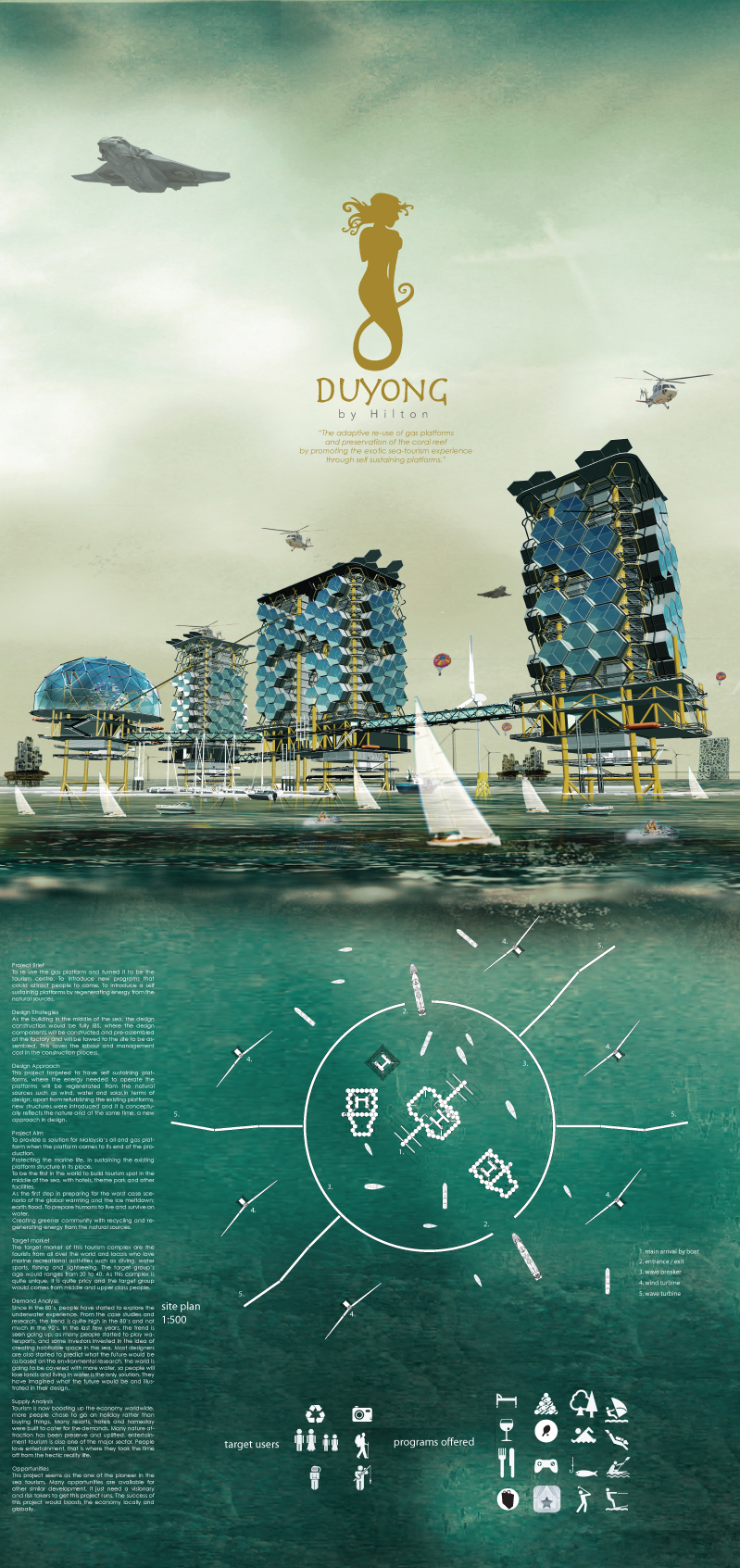
Presentation Board 3
The Proposal
Project Brief
To re use the gas platform and turned it to be the tourism centre. To introduce new programs that could attract people to come. To introduce a self sustaining platforms by regenerating energy from the natural sources.
Design Strategies
As the building in the middle of the sea, the design construction would be fully IBS, where the design components will be constructed and pre-assembled at the factory and will be towed to the site to be assembled. This saves the labour and management cost in the construction process.
Design Approach
This project targeted to have self sustaining platforms, where the energy needed to operate the platforms will be regenerated from the natural sources such as wind, water and solar.In terms of design, apart from refurbishing the existing platforms, new structures were introduced and it is conceptually reflects the nature and at the same time, a new approach in design.
The proposal of the complex consists of 4 platforms, hotel, central, administration and entertainment platform.
The concept of the design relate to the nature concept of algae that lived by parasitising on a fallen tree, and continues to live until the tree has rotten. The same concept goes to this design where the existing stuctures is considered a fallen tree and the new structure and programs as the algae that will live on the structure untill the structure really need to be disassembled or is not safe to be occupied, as the existing structure has age limit for the structure to bear the load imposed.
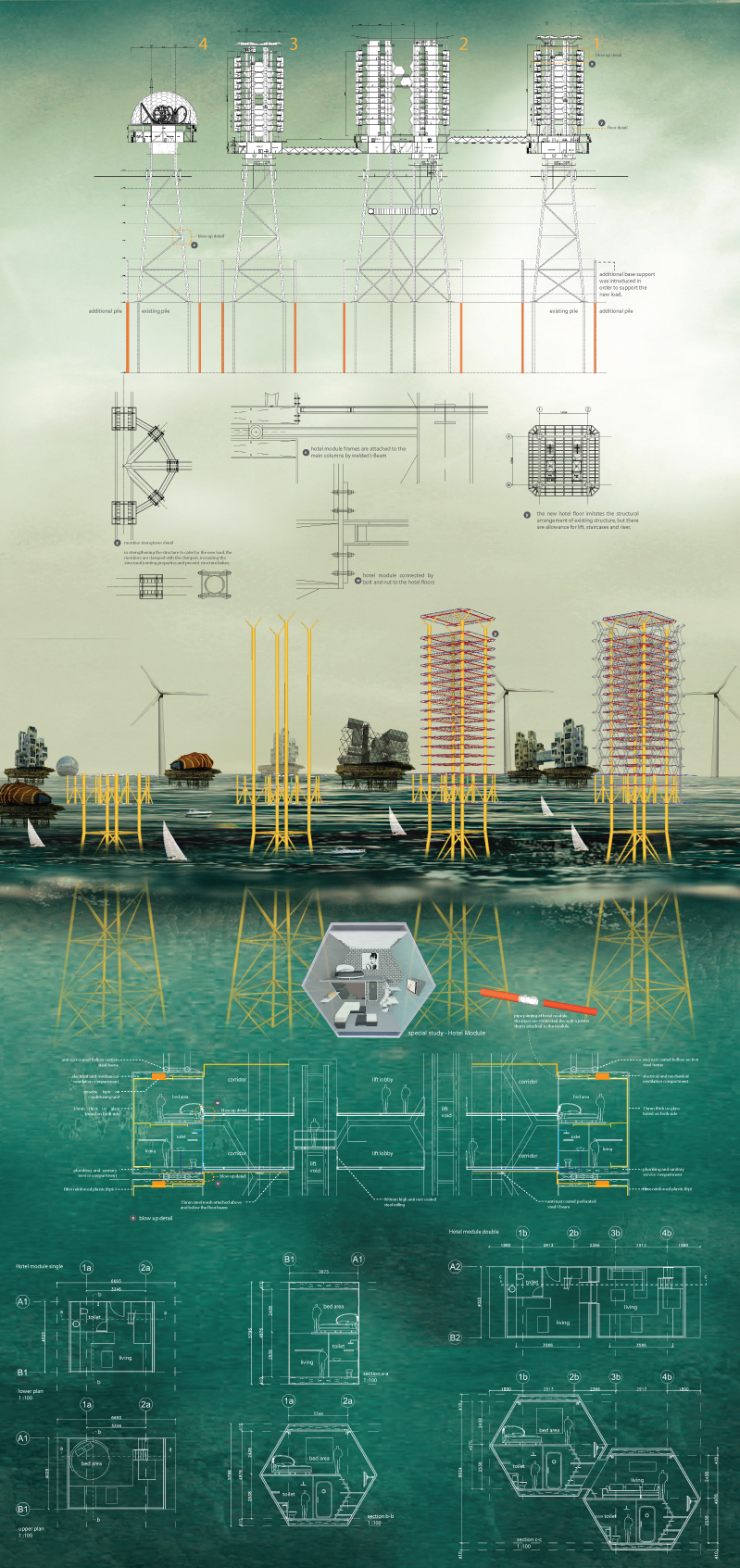
Presentation Board 4
Building section, construction, detailing and hotel unit detailed study.

Presentation Board 5
Building Plan for every platforms.

Presentation Board 6
The services and integration in every platforms.
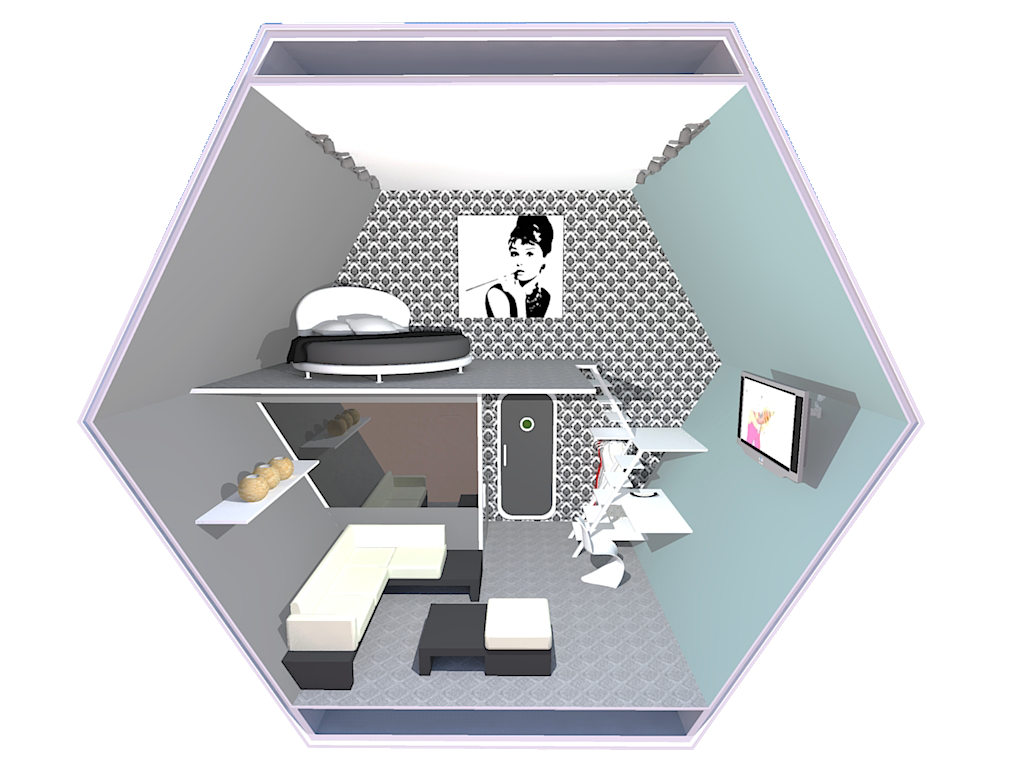
Modular hotel unit.

Scaled model of the tourism complex.
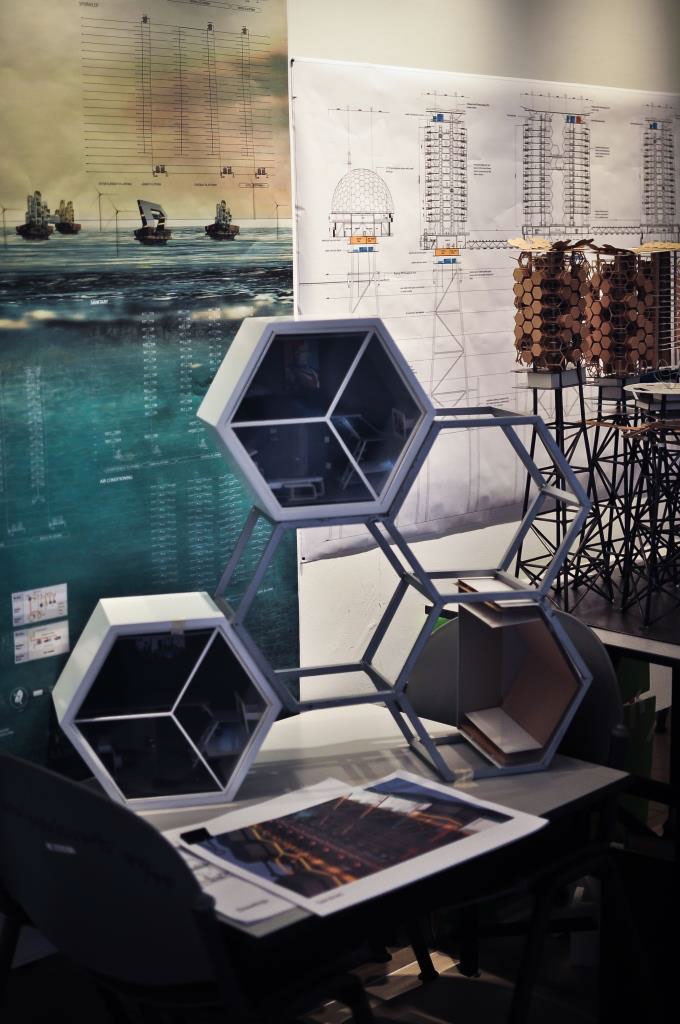
Scaled model of hotel module with structural frame.

Presentation setup.
